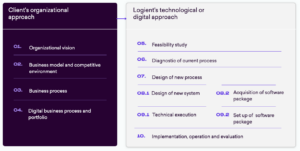
Structured Agility : The Best of Both Worlds
Logient gets back to the essence of agility
The swing of the pendulum
The word “agility” has been on everyone’s lips since the methodology associated with agile culture was born 20 years ago. However, agile practices were not adopted across the board: while some companies turned their backs on waterfall project delivery and integrated all the precepts of agility to the letter—such as the Scrum and Kanban methods—others had more difficulty making this shift. But what explains this difference? The business context? The nature of the projects? Change management? In our opinion, several factors can contribute to the qualified success of hard-line agility. We provide an overview below.
In the recent swing towards agility, many companies have forgotten not only the fundamentals of information systems design, but also the crucial steps for successful process transformation and development projects.

Instead of providing a framework for the way we design solution architecture, agility can push us towards hyper-malleability and hyper-responsiveness. It can lead us to set aside the structuring parameters of IT project management and delivery, which are seen as too rigid or too restrictive.
In response to these very real risks, Logient favours a hybrid approach: structured agility. The point is not to discard agility, on the contrary! Instead, it is a return to the essence of agile methodology, which initially combined healthy flexibility with diligent project management (within the timeframe, budget and scope). Over the years and the thousands of projects delivered, we have seen very few companies that were actually ready to adopt pure agility.
Who is agility for?
Though it is still celebrated, agility is not suitable for all types of projects. Some small projects can be easily designed in waterfall mode, while other, larger projects with partially defined or evolving needs would be better executed in agile mode.
Some types of environments are more suitable for agile projects. A relatively flexible budget, dedicated development teams and less rigid deadlines are more favorable to agility.
We have observed that most software development companies (on-demand software, customer relationship management software, commercial applications, etc.) as well as corporations and organizations such as banks and government agencies are suited to an agile culture. In addition to meeting the environmental factors listed in the following table, they control the resources that will carry out and deliver their IT projects in-house.
Remember that, in practice, agility is a set of values and business principles, not a methodology. A good solution to avoid overhauling corporate culture would be to entrust IT projects to technology partners who can advise you on the best delivery method based on your reality. Many other options are also possible, including hosting an agile team temporarily within the company, completely outsourcing the project(s) to an agile development centre, or even using a hybrid mode that combines both ways of doing things.
Towards structured agility
The great flexibility provided by agility is undoubtedly one of its top advantages. In our experience, including agile practices in project implementation can boost development efficiency and improve ROI. Nevertheless, most IT projects in a majority of companies have a budget, a schedule and a set of defined functionalities to comply with. The absence of this framework gives the project initiator the impression of losing control, although, in theory, agility was designed to provide it. Have you ever entrusted your credit card to the project initiator after giving them carte blanche, with no idea what you would receive in return? This is what the lack of a framework looks like.
In short, structured agility means maintaining iterative development practices divided into sprints around which planning, creation, validation and implementation will take place. The difference: the addition of a governance framework to carefully monitor budget, schedule and scope. In other words, the Project Office (PMO) maintains its raison d’être, manages the entire project portfolio, and assigns a Project Manager (PM) for each project. The PM supports all stakeholders in order to ensure transparency and monitor the scope, deadlines and budget.
Project manager main responsibilities
- Implementation of the contractual agreement
- Management of the scope, budget and schedule
- Implementation of the communication plan
- Removal of obstacles identified during the project
- Management of initial scope change requests and communication of risks
Advantages
- Greater awareness of the issues by customers, as they have a better understanding of the management required to achieve the final result
- Predictability (budget, timeframe, tasks to be done, reports)
- Direct and continuous line of communication with the customer
- Delivery of functional products that meet expectations through sprints and demonstrations
Conditions for success
When it comes to structured agility, direct customer involvement is crucial. Customers who lack knowledge of software development or agile culture are frequently detached from the project details. We recommend that the product owner (PO) be a member of the customer’s team because that is the best position for understanding the overall context and business issues. It is even possible to attend training sessions to learn how to tackle this role, if necessary.
Product owner (PO) responsibilities
- Agile-specific rituals: start-up sessions, grooming, sprint planning, version planning, demonstration sprint review, and post-mortem with stakeholders
- Prioritization of user stories and backlog management
- Quality of deliverables and quality assurance monitoring following user acceptance tests
- Identification of changes to the project
Finally, before launching the project, it is imperative to establish a governance structure. This structure helps define everyone’s role clearly and create a list of all deliverables, making it possible to determine the progress status and health of the project at any time. For outsourced projects, the contact person for each role must be identified, both on the customer side and on the IT partner side.
Restored confidence
If the last two decades have taught us anything, it is that agile methodologies were not a flash in the pan. Yet, for some customers, a categorical adoption of a purely agile approach is far from the best option, and in some cases, agility can lead to excessive responsiveness to change. This is why combining the advantages of agility with structuring parameters that ensure good project governance is wise.
To ensure the success of your IT projects, the Logient team has adopted an approach called “structured agility.” This hybrid approach puts the focus back on your business needs and provides you with greater supervision over your projects’ progress. It allows you to entrust the management of your mandates to project office specialists who will ensure that the budget, schedule and scope are respected, and will communicate with you proactively. In such a context, development teams can devote all their energy and talent to developing features.
By doing business with Logient’s experienced team, you can count on a partner that puts customer needs and participation at the core of its work.
Contact our specialists today !



















